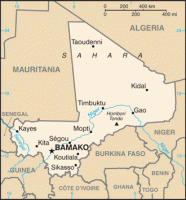
This post, written by Danny Hirschel-Burns, our Policy Coordinator, is the fourth in our “Countries to Watch” series, which focuses on developing conflicts. Read our previous Country to Watch posts on Turkey, Russia, and Brazil. Check back for more posts in this series.
Though violent insurgency in northern Mali is not a new phenomenon, the current crisis in Mali started in January of 2012 when Tuareg separatists, an Arab ethnic group in northern Mali, allied with Islamists and launched a rebellion against the Malian government in Bamako. In the face of the Tuareg advance, the Malian army retreated without much resistance. In response to a perceived lack of government effort in funding and organizing the war effort, Malian officers mutinied, and the mutiny ended up toppling the government. The leaders of this mutiny installed a military junta to rule the country. This new government was also unable to stop the rebel advance. Over the course of the war, Tuaregs, mostly represented by the National Movements for the Liberation of Azawad (MNLA), lost internal power to Islamists from Ansar Dine and the Movement for Oneness and Jihad in West Africa (MUJAO). As the rebels approached Bamako, former colonial power France stepped in at the request of the junta, driving the rebels back into the northern desert with the help of Chadian troops and crucial air support. French troops pulled out recently, leaving security work to Malian and African forces and a UN peacekeeping mission.
There were multiple causes of the conflict. Many Tuareg had fought in Libya as mercenaries for Gaddafi, and following his fall, heavily-armed, well-trained Tuaregs flowed back in northern Mali. Tuaregs have been historically neglected by the Malian government, and numerous Tuareg rebellions have happened in the past. While Tuaregs constituted a type of economic elite in Northern Mali, they had comparatively little political power. Tuaregs are spread out across several countries, but they do not form a majority in any (they are not even the majority in sparsely-populated northern Mali). A struggle for control of trade and smuggling networks was also a main cause of the rebellion. Finally, following initial military success of Tuareg separatists, local and Algerian-based Islamists joined the cause when they sensed the opportunity to implement Sharia in an entire country. While the situation on the ground is much changed from the height of the rebellion, many of the conflict’s drivers continue to create tension.
The French intervention was crucial in upending the rebel advantage, but it did little to address the root causes of the crisis. The French approach was a short intervention aimed at nothing more than gaining a military advantage. The lack of a diplomatic front meant the metaphorical can was just kicked farther down the road. Local tensions, which caused splits even within rebel groups, continue to fester. While racial frictions within Northern Mali remain an issue, north-south tension threatens the precarious stability and territorial integrity of the country. Though the MNLA supported the French during the latter stages of the intervention, the government in Bamako and Mali’s non-Tuaregs are still deeply suspicious of the organization. A preliminary agreement was signed between Bamako and MNLA, but political pressures have prevented most major southern politicians from endorsing the deal. With further negotiations after the national election scheduled for July 28th needed to solidify the agreement, the chances for a future, inclusive peace deal aren’t looking up. And while the Malian army has finally gained the permission of the MNLA to enter the organization’s stronghold town of Kidal, there is not a clear disarmament plan for former rebels.
Many problems produced during the pre-crisis period and the French intervention remain in Mali, and the proposed solutions look unlikely to fix most of them. The UN peacekeeping mission in Mali is currently short of funding due to the inertia of the US budgeting process, and will take awhile to reach its full strength of 12,640 soldiers. In the meantime, much of northern Mali will remain as ungoverned spaces. The lack of state presence, in the form of both governance and military force, allows many former combatants (mostly Islamists) to fade back into the general population. Without an effective demobilization, disarmament, and reintegration (DDR) program for northern Mali, many of these ex-combatants will become active in moments of instability in the future (though it will be because of national issues rather than international jihad). The upcoming elections have more riding on them than any other proposed solution, but they are almost certainly destined to fail. The distribution of national ID cards needed for Malians to cast their votes is behind schedule, and many Malian politicians have been frank with the fact the country is not ready for elections. Due to the delay, Malian professor Issa N’Diayetold the VOA, “The vote will be legal, but it won’t be legitimate.” These elections are therefore unlikely to give the Malian people much confidence in their new government. Unsecured sham elections could well instigate another crisis. As Severine Autesserre warns in her book The Trouble with the Congo, Western peacebuilders often push elections too quickly on societies coming out of episodes of severe violence, leading to a broken political system. She argues that the massive resources required to organize an election would be better spent on local peacebuilding initiatives that stabilize a country and help prepare it for future elections. This mistake looks set to be repeated again in Mali.
